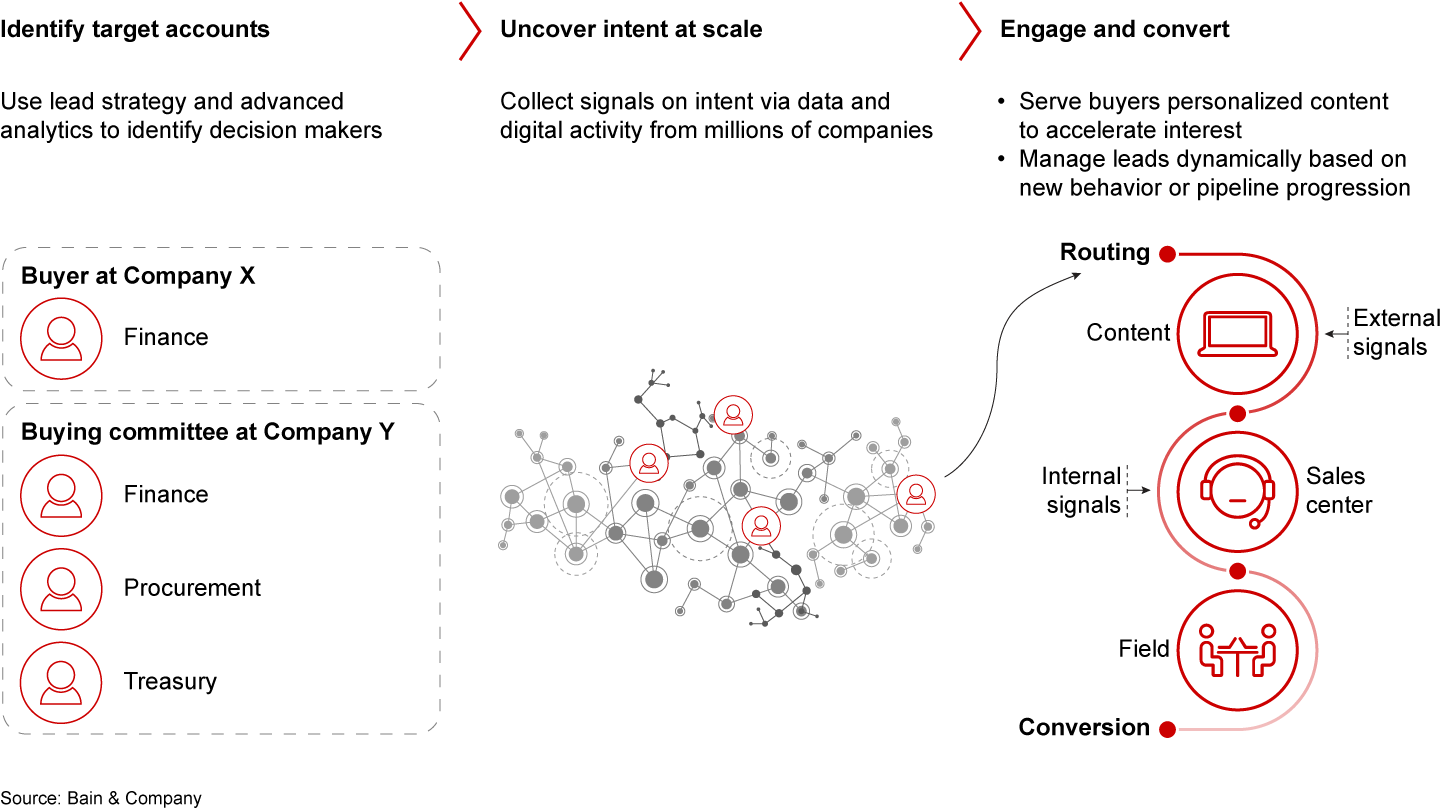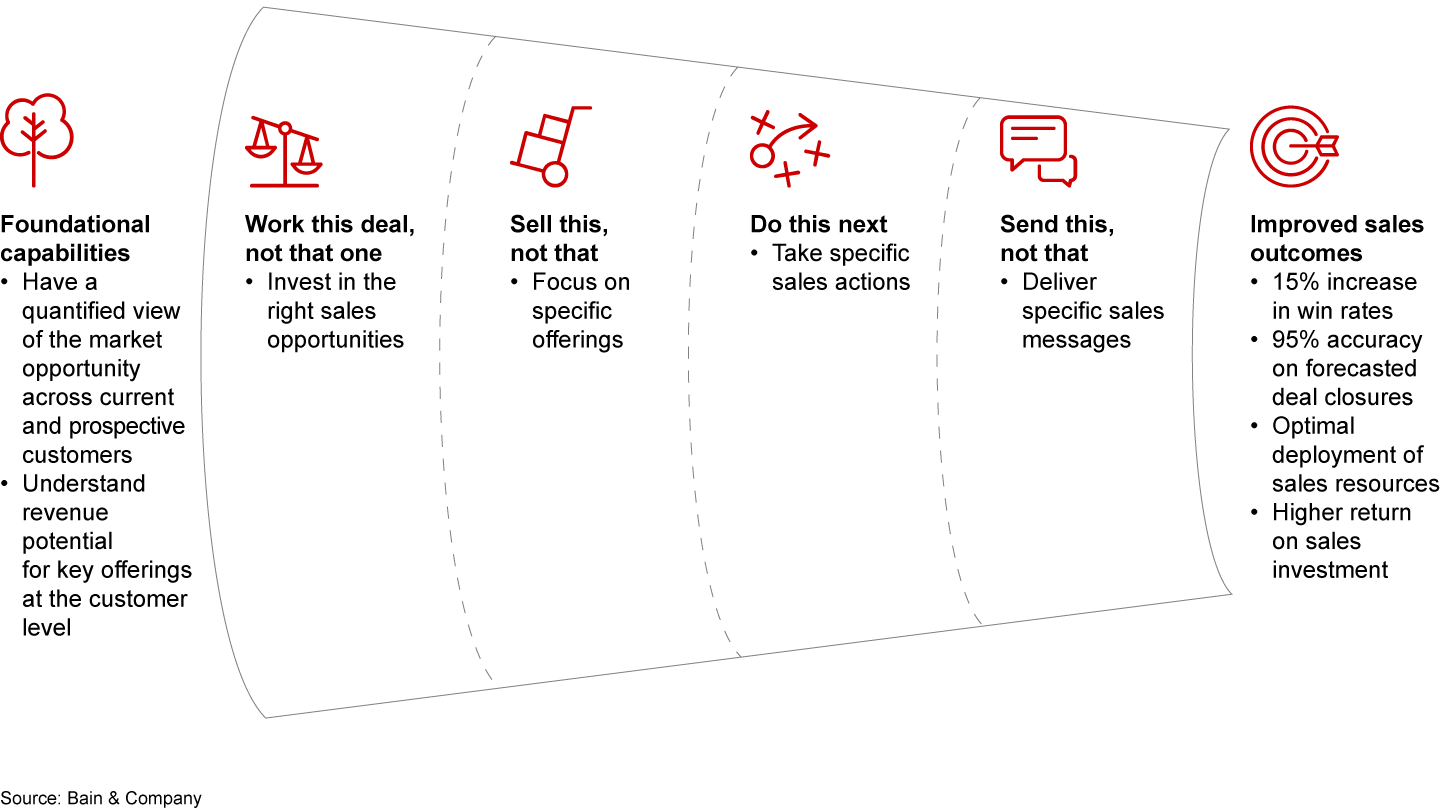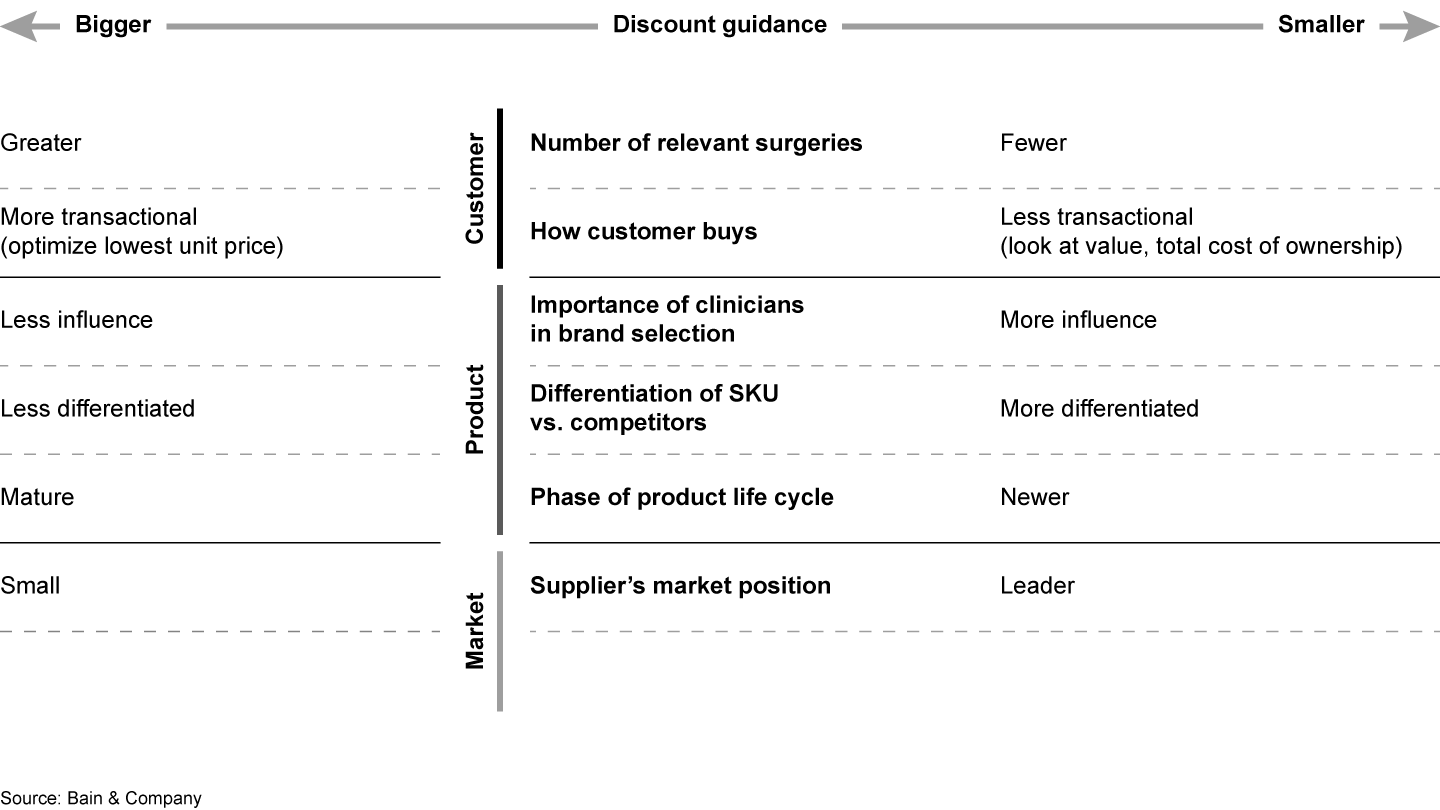論説
 }
}
概要
- Beyond generating insights, leading sales and marketing groups deploy analytics to prescribe specific actions that raise the odds of closing or expanding deals.
- Prescriptive analytics frequently takes three forms: guided marketing, guided selling and guided pricing.
- These forms of guidance all hinge on the organization having a solid analytical foundation and the right processes and technology applications to use analytics.
- Companies can get started on a small scale, however, even if they lack fully integrated, high-integrity data.
Sales and marketing organizations are grappling with a flood of data and deploying analytics to improve the quality of the insights being generated. While the underlying analytical methods have been around for decades, advanced analytics has only recently become accessible for most business-to-business (B2B) organizations via the confluence of abundant data, cheap computing, open sources and a large ecosystem of technology applications.
The key challenge now is determining the best moves to make based on the insights produced by the analysis. Leading companies have begun to deploy prescriptive analytics—that is, guided actions on specific customer or prospect opportunities that flow from predictive insights. When applied to sales and marketing, prescriptive analytics can help companies improve the return on their investments, optimize conversion and win rates, or maximize profit margins.
Within the commercial organization, prescriptive analytics takes three forms—namely, marketing, selling and pricing—each serving to guide people toward actions that produce better sales and marketing outcomes. These forms of guidance all hinge on the organization having a solid analytical foundation. There’s no shortcut to prescribing actions, although there are ways to get started on a small scale.
Guided marketing
Successful companies meet and engage customers wherever they are in the process, using relevant content and channels. Advanced analytics can produce smarter responses to the ways that customers explore, research and buy in nonlinear journeys. It takes marketing activation to the next level by guiding buyers through the journey with increasingly less human intervention (see Figure 1).

In this context, one foundational capability is having a clear view of who the right buyers are and identifying them at the right time, such as when they are likely to enter a buying cycle. Using machine learning through applications such as those developed by Lattice Engines, companies can deploy scoring and prioritization techniques to develop ideal customer profiles, and use intent signals to identify high-propensity prospects searching for the company’s products or services in real time.
Demand orchestration platforms such as Demandbase can then assign these prospects to high-fit, high-interest audiences of prospective customers. The platforms typically evaluate thousands of company attributes, ranging from standard firmographic details of industry or company size to technographics such as which applications a company likely uses behind its firewall. When linked to additional data sources such as DiscoverOrg or ZoomInfo, insights about potential buyers can extend down to the contact level. Marketers and sales reps know who key buyers and influencers are, who reports to whom and even what internal projects appear to be active within target companies.
Building on this foundation, prescriptive analytics guides marketers in several ways. One is delivering the right content at the right moment, typically through digital channels. The content could be a vendor’s own website recommending personalized marketing collateral relevant to the company and role of the visitor, or targeted ads on demand-side platforms.
Guidance can quickly become outdated as prospect behavior changes, so dynamic audience management reclassifies or reroutes buyers at each new step taken by buyer or seller. After a productive discussion with a high-value prospect, a sales rep would note that stage in the customer relationship management (CRM) system, which triggers a new set of prescribed activities for other decision makers at the target company.
Being prescriptive allows organizations to work on a more focused set of high-quality leads and opportunities. Technology company Masergy used these methods to improve customer acquisition. Masergy began with customer intent data, using Lattice Engines to identify target accounts and prioritize leads. It then designed and deployed highly personalized, multichannel engagement programs against those targets, with focused messaging based on segment, buyer profile and sales cycle stage. Accounts targeted this way had a 50% higher win rate—in large part because the campaigns were tailored to senior-level decision makers who engaged with Masergy in half of the initial sales conversations that occurred as a result of the guided marketing programs.
Guided selling
Turning to the sales organization, analytics can proactively recommend actions that sales reps should take. The key foundational capability here is having a quantified view of the market opportunity for both new and existing accounts. Understanding the revenue potential for key offerings at an account level helps companies determine how and where to deploy sales resources. Analytics guides sellers along several dimensions (see Figure 2).

- Work this deal, not that one—invest in the right sales opportunities. Traditional pipeline management relies heavily on the sales rep’s input; if a rep deems a deal to be high value and high probability, she will aggressively work that deal. Her manager might inspect the deal, but typically has little basis for questioning the rep’s assessment. By contrast, analytics-based pipeline scoring applications such as Aviso can independently assess the probability that a deal will close based on modeling the attributes of comparable past deals won or lost. That gives managers solid data with which to direct their reps so that reps do not waste time chasing low-probability deals.
- Sell this, not that—focus on specific offerings. Commercial organizations with large product sets or complex offerings that require configuration or customization are developing packages for reps to take to customers. An internal recommendation engine determines the appropriate offer based on the characteristics of the specific customer and opportunity.
- Do this next—take specific sales actions. Even in the high-probability scenarios described above, certain actions can further raise the probability of closing the deal. Insights derived from analyzing successful pursuits or sales reps also help define the appropriate sales cadence—say, a sequence of 15 touchpoints, using social, email, rich media and phone calls, over 30 days. Cadences such as these are prescribed to reps and bolstered by periodic reminders through engagement platforms such as SalesLoft and InsideSales.
- Send this, not that—deliver specific messages. While no artificial intelligence assistant can yet whisper in a rep’s ear during sales calls, leading companies use applications that prescribe content and messaging relevant to the customer’s segment, buyer persona, industry and stage in the sales process. Sales enablement platforms such as Seismic can store and serve content that has already been customized to communicate a particular value proposition, that gets automatically triggered within CRM and that comes from the rep’s email address. Some companies with inside sales or contact centers also use multivariate testing to optimize language in call scripts so that reps say precisely the right thing at the right time.
A more prescriptive approach improves the effectiveness of individual salespeople and the overall go-to-market model. One global technology company worked with Aviso on a prescriptive approach to managing its sales pipeline. Aviso’s software scored each sales opportunity and forecast the probability of each deal closing within the quarter. The application recommended specific deals to focus on and highlighted opportunities that were at risk, which allowed sales leaders to reallocate resources to pursue the most critical opportunities. The analytics forecast which deals would close within the first three weeks of the quarter with 95% accuracy, giving the salesforce plenty of time to act on the recommendations provided. As a result, the technology company increased win rates by 15%.
Guided pricing
Analytics provides guidance on price levels and discounts based on market, competitive, internal and customer-level data, allowing reps to maximize the profit margin on each transaction. The process begins by defining which variables matter most to getting the optimal price—it’s often much more than customer size or type, which is where many companies stop. Instead, the variables that make the price equation more dynamic and reliable might include the customer’s end market, length and quality of the relationship, size of order and time of year, and real-time competitive activity. Combining that analysis with market research helps a company define a more effective price equation for any transaction.
With the first version of the price guidance equation built, companies can enhance their capability in several ways.
- Test additional variables from historical data in order to customize for regions or small segments of customers.
- Add variables that would increase the accuracy of pricing decisions, such as third-party data on competitor share or pricing, or forecasts of raw material costs. A medical device company, for instance, could combine a range of variables to optimize the discount levels it allows on different products (see Figure 3). These variables, in themselves, don’t break new ground, but what the leading companies do well is apply them across the entire portfolio of SKUs and customers to set guidance for the pricing and sales teams.

- Update the model more frequently, and push the best data to the front lines more rapidly to make the model dynamic. A retail gasoline company may choose to change prices two to three times a day to capture intraday opportunities.
- Build in test-and-learn feedback loops that evaluate win-loss data, customer attrition and lifetime value metrics in order to push pricing close to full willingness-to-pay thresholds for certain customer segments and transactions.
The most advanced companies are also using this logic to create if/then modeling that can solve for a specific outcome with price as the key input variable—such as what price is needed to double pipeline conversion rates this quarter or meet certain market share targets.
Analytics also informs the inevitable chain of price approvals that remain. Typically, when a deal price falls outside the authorized band, the deal elevates to a manager, but few companies arm these approvers with robust information to guide their decision. Analytics provides recent quotes and orders for similar customers or products, estimates a win rate at that price and higher prices, and takes real-time competitive information into account. This information allows approvers to direct the sales rep regarding a realistic price to seek. The logic can also highlight which deal or customer variables suggest that the current price is too low, giving the sales team a viable script to use during negotiations.
Dynamic pricing guidance has delivered meaningful financial benefits to a range of B2B companies. One manufacturing company in Europe was struggling with prolonged price quote conversion times and sinking profit margins. The company worked with cloud pricing software provider Pricefx to optimize price quotes in real time. By embedding price quotes into the manufacturer’s Salesforce system, sales reps were able to create quotes quickly on their smartphones. The average quote conversion time dropped from 48 hours to 4 hours, and the manufacturer realized a 50-basis-point improvement in pricing as well as a higher win rate.
Getting started without fretting about the data
Some marketers and sales heads hesitate to embrace prescriptive analytics because they lack all the data to set a firm foundation. But while the “garbage in, garbage out” axiom certainly applies, having low-fidelity data doesn’t mean that executives need to wait until they have completed a massive data integrity and integration effort. Make early progress with the data at hand through the following principles.
- Pick one micro-battle. Based on management’s growth expectations, understanding of the opportunities and the company’s marketing/sales mix, select one or two specific, narrowly defined topics, such as developing an ideal customer profile, building a quantified view of the market opportunity or defining basic price target zones.
- Define the minimum viable input to begin providing guidance to the salesforce. The effort could start with a heavier reliance on third-party data and fairly manual processes before developing ample proprietary internal data with highly automated processes.
- Know how and when to measure success. Specify the metrics for activities and outcomes, as well as a date by when results should materialize. That avoids pulling the plug prematurely, and it provides an objective rationale to extend the use of prescriptive analytics once you succeed with an early project.
- Spread the word. Repeat. Communicate regularly with the sales and marketing groups about how prescriptive analytics improves outcomes for them and the company overall so that they trust the guidance offered.
Analytics doesn’t replace human judgment, but it has become reliable enough that commercial leaders should start incorporating analytics into prescriptive playbooks. Organizations that refine their processes to take advantage of these approaches will raise the return on their sales and marketing activities.
Chris Dent is a principal and David Burns and Saber Sherrard are partners with Bain & Company’s Customer Strategy & Marketing practice. They are based, respectively, in Chicago, Chicago and Dallas.


